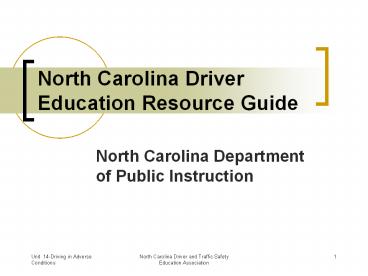North Carolina Driver Education Resource Guide - PowerPoint PPT Presentation
1 / 10
Title:
North Carolina Driver Education Resource Guide
Description:
Adverse conditions should include anything that makes the driving task more difficult. ... A. Perception time/distance. B. Reaction time/distance. C. Braking distance ... – PowerPoint PPT presentation
Number of Views:61
Avg rating:3.0/5.0
Title: North Carolina Driver Education Resource Guide
1
North Carolina Driver Education Resource Guide
- North Carolina Department of Public Instruction
2
DRIVING IN ADVERSE CONDITIONS
- Unit 14
3
Adverse conditions usually refer to traction or
visibility. Adverse conditions should include
anything that makes the driving task more
difficult.
Adverse conditions
4
The goal, when driving in adverse conditions, is
to recognize and understand their limitations
while driving accordingly. Adverse conditions
include A. Rain B. Snow C. Fog and darkness
D. Sunglare E. Other vehicles blocking vision
Driving in adverse conditions
5
When dealing with reduced visibility, you can
A. Slowdown B. Increase following distance C.
Have clean windshield, headlights, etc. D. Use
driving aids, reflectors, painted lines, other
headlights and streetlights E. Turn down panel
lights, no interior lights F. Replace wiper
blades and have washer fluid G. ALWAYS turn on
your lights in reduced visibility. Make sure
others see you!
Ways to deal with reduced visibility
6
Sixty percent of fatal accidents occur at night.
7
There are many ways to deal with reduced
traction. Slow down Increase following
distance Drive in another driver's tire track
Make sure of your tire pressure Make no sudden
movements, braking, turning or accelerating Keep
moving in snow or ice If conditions warrant,
stay off the roads
Ways to deal with reduced traction
8
If you are dealing with deep water you should do
the following A. Check the depth of water
using other vehicles or landmarks. B. Never
enter deep water that is moving. It can float
your vehicle off the road with disastrous
results. C. Always wait for other vehicles to
clear the area. This allows you to drive in the
middle of the road surface where the water is the
shallowest. It will also avoid!" splashing water
into your engine compartment. D. Always go slow
to avoid water splashing into your engine. E.
Never take chances with deep water. Find another
route.
How to deal with deep water on the road
9
The advent of antilock brakes has created some
unforeseen problems. Unlike standard brakes, you
just push them down and hope. If the driver
"pumps" them, they will not stop the vehicle.
Standard brakes and anti-lock brakes
10
The three parts of total stopping distance are
A. Perception time/distance B. Reaction
time/distance C. Braking distance
Parts of total stopping distance































